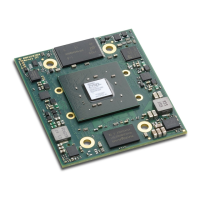1.3 Deliverables
• Mercury ZX1 SoC module
• Mercury ZX1 SoC module documentation, available via download:
• Mercury ZX1 SoC Module User Manual (this document)
• Mercury ZX1 SoC Module Reference Design [2]
• Mercury ZX1 SoC Module IO Net Length Excel Sheet [3]
• Mercury ZX1 SoC Module FPGA Pinout Excel Sheet [4]
• Mercury ZX1 SoC Module User Schematics (PDF) [5]
• Mercury ZX1 SoC Module Known Issues and Changes [6]
• Mercury ZX1 SoC Module Footprint (Altium, Eagle, Orcad and PADS) [7]
• Mercury ZX1 SoC Module 3D Model (PDF) [8]
• Mercury ZX1 SoC Module STEP 3D Model [9]
• Module Pin Connection Guidelines [10]
• Mercury Master Pinout [11]
• Enclustra Modules Heat Sink Application Note [17]
• Enclustra Build Environment [14] (Linux build environment; refer to Section 1.4.2 for details)
• Enclustra Build Environment How-To Guide [15]
1.4 Accessories
1.4.1 Reference Design
The Mercury ZX1 SoC module reference design features an example configuration for the Zynq-7000 SoC
device, together with an example top level HDL file for the user logic.
A number of software applications are available for the reference design, that show how to initialize the
peripheral controllers and how to access the external devices. Pre-compiled binaries are included in the
archive, so that the user can easily check that the hardware is functional.
The reference design can be downloaded from the Enclustra download page [2].
1.4.2 Enclustra Build Environment
The Enclustra Build Environment (EBE) [14] enables the user to quickly set up and run Linux on any Enclustra
SoC module or system board. It allows the user to choose the desired target, and download all the required
binaries, such as bitstream and FSBL. It downloads and compiles all required software, such as U-Boot, Linux,
and BusyBox based root file system.
The Enclustra Build Environment features a graphical user interface (GUI) and a command line interface (CLI)
that facilitates the automatic build flow.
The Enclustra Build Environment How-To Guide [15] describes in more detail how to use the EBE to customize
the provided software for the user application. The document provides information on the configuration
options for U-boot, Linux kernel and Buildroot, debugging possibilities for Linux applications, customization
of device trees and integration of existing or new kernel drivers.
1.4.3 Mercury+ PE1 Base Board
• 168-pin Hirose FX10 module connectors (PE1-200: 2 connectors; PE1-300/400: 3 connectors)
• System controller
• Power control
• System monitor (PE1-300/400)
• Current sense (PE1-300/400)
• Low-jitter clock generator (PE1-300/400)
• Accelerometer/magnetometer/temperature sensor (PE1-300/400)
D-0000-403-002 8 / 56 Version 05, 25.07.2019

